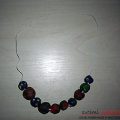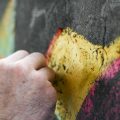
The main important points in modeling classes with children aged 4-5 years, recommendations for classes.
Modeling crafts from various plastic materials- is a very popular type of handicraft and hobby. Children and adults create a variety of things from clay, plasticine, dough, plaster, plastic and even from culinary mastic. For children, such a pleasant pastime also performs a developmental function. All fingers and palms of the baby are involved in modeling. This has a beneficial effect on the baby's fine motor skills, which in turn contributes to the development of memory, vocabulary, speech, imagination and creative thinking, as well as the ability to concentrate. In children at the age of five, their understanding of the shape of an object has already slightly increased, but they are not yet able to correctly convey all the proportions, and very often individual parts of the craft are not well secured. At the same time, babies aged four to five years already perceive verbal instructions better. The teacher continues lessons on using the entire brush and fingers, developing an interest in modeling. The teacher also clarifies the understanding of the shapes of objects, the structure and proportions of individual elements and teaches how to convey them in modeling. In the middle group, more emphasis is placed on the aesthetics of depicting various shapes and their symmetry. The requirements for choosing independent tasks, methods and techniques for completing them are increased. Children need to be able to mold a shape with their fingertips and tightly secure the joints of large elements, mold small parts with a stick, or pinch them. The first modeling lessons in the middle group will be needed so that the children remember what they were taught in the younger group. They will roll a piece of material straight or in a circle and flatten it between their palms. This will help to consolidate previously learned knowledge and more correctly complete the teacher's tasks. Children mold not only with their palms, they try to convey the features of the forms with their fingers. For example, a carrot is elongated and oval. Children must control their actions visually, and also clearly imagine the entire image of the object as a whole. Before the beginning of winter, children make already known crafts, improve their ability to convey shapes and modeling techniques. All winter long, kids make crafts from one or another material.whole piece, these can be vegetables or fruits, or they can create products from several parts, for example, a cat, a doll, a snowman or a bunny. Children already know how to mold individual elements of these objects, but the proportions and methods of attachment need to be adjusted. In the younger group, the kids molded a tumbler from two balls, in the lessons in the middle group, the teacher will suggest molding a snowman, his body consists of three balls - a large one, a smaller one and a very small one. You can mold the snowman's hands, nose, or hat.
All winter long, kids make crafts from one or another material.whole piece, these can be vegetables or fruits, or they can create products from several parts, for example, a cat, a doll, a snowman or a bunny. Children already know how to mold individual elements of these objects, but the proportions and methods of attachment need to be adjusted. In the younger group, the kids molded a tumbler from two balls, in the lessons in the middle group, the teacher will suggest molding a snowman, his body consists of three balls - a large one, a smaller one and a very small one. You can mold the snowman's hands, nose, or hat.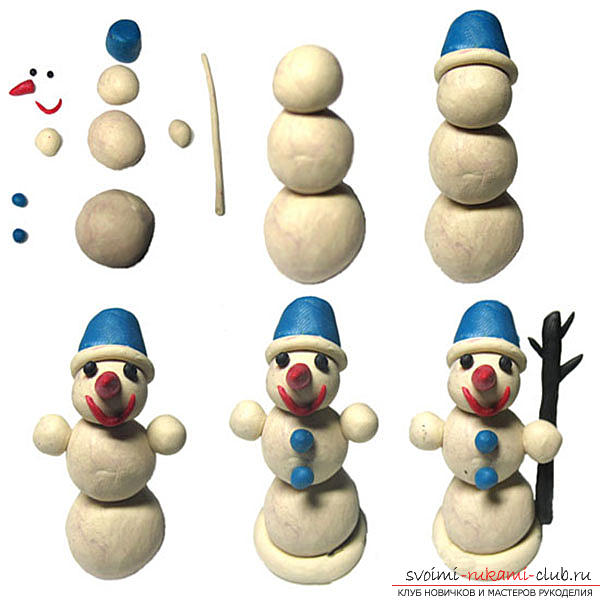 A more challenging task would be a sitting cat.To begin with, the little ones mold a cylindrical body, then a sausage-shaped tail and a ball-shaped head. The cat's front paws are made by pinching, and since it is sitting, the back ones can be omitted. New methods of shaping appear. Children learn to round or, on the contrary, sharpen the end of a sausage with their fingers, pinch the edges of flat cakes, giving the craft a more beautiful shape. The next three months will be devoted to pulling the material (clay, plasticine, etc.) when creating small parts, pressing with fingers to create hollow crafts. The little ones will practice better smearing the material on the edges of joints for a tighter connection of parts and bending flattened edges to form dishes. Here is a fish, it can be molded from one piece. Make it oval. Pull out one part of the plasticine a little and round it off, this will be the head, pull out the other part more and flatten it at the end, making it flat – this is the tail. The fins are molded by pinching the plasticine, and then using a stack, draw scales or stick them on top from small pieces of plasticine. This exercise will help kids learn how to correctly convey the shape of an object and compare its parts with each other by shape and size. It is also necessary to teach children to divide the clay into the required number of parts. Here is a bird. One lump of plasticine should be divided into two parts. From one, mold the bird's body, and from the other, the head and stand. Another craft for this period is dishes. It is made in two ways. The first is to press your finger into a round or cylindrical blank. You will get a mug or a glass. Children can make a handle for a cup or mug by pinching and pulling the material away from the entire workpiece or by sticking a small sausage, smearing the joints. The edges of a flat pancake are bent, so the children will get a plate or saucer. Children can decorate all the crafts, if they wish, by drawing patterns with a stack or sticking it from additional flat cakes or sausages of plasticine. Decorating their crafts, children receive positive emotions, and a sense of symmetry develops.
A more challenging task would be a sitting cat.To begin with, the little ones mold a cylindrical body, then a sausage-shaped tail and a ball-shaped head. The cat's front paws are made by pinching, and since it is sitting, the back ones can be omitted. New methods of shaping appear. Children learn to round or, on the contrary, sharpen the end of a sausage with their fingers, pinch the edges of flat cakes, giving the craft a more beautiful shape. The next three months will be devoted to pulling the material (clay, plasticine, etc.) when creating small parts, pressing with fingers to create hollow crafts. The little ones will practice better smearing the material on the edges of joints for a tighter connection of parts and bending flattened edges to form dishes. Here is a fish, it can be molded from one piece. Make it oval. Pull out one part of the plasticine a little and round it off, this will be the head, pull out the other part more and flatten it at the end, making it flat – this is the tail. The fins are molded by pinching the plasticine, and then using a stack, draw scales or stick them on top from small pieces of plasticine. This exercise will help kids learn how to correctly convey the shape of an object and compare its parts with each other by shape and size. It is also necessary to teach children to divide the clay into the required number of parts. Here is a bird. One lump of plasticine should be divided into two parts. From one, mold the bird's body, and from the other, the head and stand. Another craft for this period is dishes. It is made in two ways. The first is to press your finger into a round or cylindrical blank. You will get a mug or a glass. Children can make a handle for a cup or mug by pinching and pulling the material away from the entire workpiece or by sticking a small sausage, smearing the joints. The edges of a flat pancake are bent, so the children will get a plate or saucer. Children can decorate all the crafts, if they wish, by drawing patterns with a stack or sticking it from additional flat cakes or sausages of plasticine. Decorating their crafts, children receive positive emotions, and a sense of symmetry develops.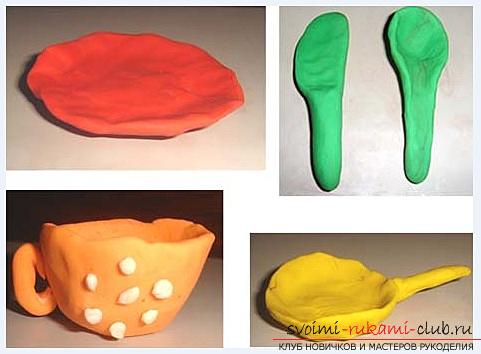 In the summer, the kids consolidate their acquired knowledge andskills. At the same time, the teacher can give not only familiar crafts to do, but also new ones, but only those that are within their power, for example, a mouse, a hedgehog, mushrooms in a basket or a plate with berries. During all periods of study, classes have a theme. Some are assigned by the teacher, and some children choose themselves. Often, children sculpt what they can already do. The main goal of such lessons is for children to learn to independently come up with a theme, complete the work, apply all the sculpting forms known to them and independently work on a clearer form of the craft and adding additional elements to it. In order for the program to be successfully studied and consolidated, appropriate teaching methods are needed that activate children's attention in sculpting lessons and expand their understanding of the life around them. On walks, the teacher invites children to carefully examine objects that can become objects of sculpting. How birds peck food or fish swim in an aquarium. The teacher points out only the basic shape of the object, the basic structure and proportions, those details of the object that the children will already be able to understand and mold. Here is a bird, it has a round head, an oval body and a flat tail. The bird's head is on top, it has a small beak, and the tail is below. And here is a small hedgehog, it has a small muzzle and an oval body, it got scared and curled up into a ball. Such explanations help children connect the image of the animal and its position with the actions it performs.
In the summer, the kids consolidate their acquired knowledge andskills. At the same time, the teacher can give not only familiar crafts to do, but also new ones, but only those that are within their power, for example, a mouse, a hedgehog, mushrooms in a basket or a plate with berries. During all periods of study, classes have a theme. Some are assigned by the teacher, and some children choose themselves. Often, children sculpt what they can already do. The main goal of such lessons is for children to learn to independently come up with a theme, complete the work, apply all the sculpting forms known to them and independently work on a clearer form of the craft and adding additional elements to it. In order for the program to be successfully studied and consolidated, appropriate teaching methods are needed that activate children's attention in sculpting lessons and expand their understanding of the life around them. On walks, the teacher invites children to carefully examine objects that can become objects of sculpting. How birds peck food or fish swim in an aquarium. The teacher points out only the basic shape of the object, the basic structure and proportions, those details of the object that the children will already be able to understand and mold. Here is a bird, it has a round head, an oval body and a flat tail. The bird's head is on top, it has a small beak, and the tail is below. And here is a small hedgehog, it has a small muzzle and an oval body, it got scared and curled up into a ball. Such explanations help children connect the image of the animal and its position with the actions it performs.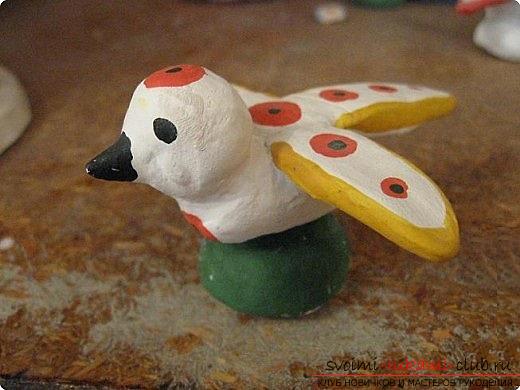 The teacher can take the depicted object into his handsobject, show the general shape, and then name and show the details. Children develop an idea of the proportions of the object and the shape of its individual elements. Also, comparisons of unfamiliar elements with those already known to the children will help with modeling, for example, that the doll's arms are columns, and the body resembles a carrot in shape. The teacher demonstrates the creation process, kneading the material and molding the desired detail, and accompanies it with a story. Here is a hedgehog. It has an oval body. Similar to an egg. First, you need to roll a ball, and then roll it back and forth in your palms, its shape has changed a little, now you need to stretch one side a little with your fingers. This is the muzzle. Children 4 - 5 years old do not always manage to mold an oval shape the first time or firmly connect the parts by gluing. All babies are different, if someone did not succeed the first time, other children can show them. At this age, children can already be offered to depict not only the image as a whole, but also individual characteristic features. For example, a hole in the base of an apple or a stalk of an eggplant. To make it more interesting for children, you can make carrot tops or apple leaves from cardboard. Gradually, the kids will learn to create these details from plasticine or other material. To make the images of crafts more vivid, you can offer to examine and then mold toys or figures already made by the teacher. At first, these can be two figures of the same type, for example, birds, but one will peck at seeds, its body and head are tilted, and the second is just walking and its body is located evenly. Or these can be rabbits, one holds a carrot in its front paws, and the second is just sitting, and the carrot lies nearby. Such activities help children think about the variety of images. It may be beyond the kids' strength to mold several figures, so let them focus on the one they liked the most. You can play with the theme and the result of the work. The kids make birds and place them in one common feeder.
The teacher can take the depicted object into his handsobject, show the general shape, and then name and show the details. Children develop an idea of the proportions of the object and the shape of its individual elements. Also, comparisons of unfamiliar elements with those already known to the children will help with modeling, for example, that the doll's arms are columns, and the body resembles a carrot in shape. The teacher demonstrates the creation process, kneading the material and molding the desired detail, and accompanies it with a story. Here is a hedgehog. It has an oval body. Similar to an egg. First, you need to roll a ball, and then roll it back and forth in your palms, its shape has changed a little, now you need to stretch one side a little with your fingers. This is the muzzle. Children 4 - 5 years old do not always manage to mold an oval shape the first time or firmly connect the parts by gluing. All babies are different, if someone did not succeed the first time, other children can show them. At this age, children can already be offered to depict not only the image as a whole, but also individual characteristic features. For example, a hole in the base of an apple or a stalk of an eggplant. To make it more interesting for children, you can make carrot tops or apple leaves from cardboard. Gradually, the kids will learn to create these details from plasticine or other material. To make the images of crafts more vivid, you can offer to examine and then mold toys or figures already made by the teacher. At first, these can be two figures of the same type, for example, birds, but one will peck at seeds, its body and head are tilted, and the second is just walking and its body is located evenly. Or these can be rabbits, one holds a carrot in its front paws, and the second is just sitting, and the carrot lies nearby. Such activities help children think about the variety of images. It may be beyond the kids' strength to mold several figures, so let them focus on the one they liked the most. You can play with the theme and the result of the work. The kids make birds and place them in one common feeder. So that children learn correctlyconvey proportions, the teacher makes a comparison. If the kids are making a doll, the teacher takes a pre-molded sausage (a blank for the handles), divides it in half and compares them, establishing the length. Another comparison method can be used when making a basket from rings. The kids make a flat cake bottom and 4 sausages. 3 sausages are for the sides of the basket, and the fourth is the handle. The kids put one of the sausages to the bottom, and if it turns out to be longer, then the excess is cut off. All the following sausages are aligned with the first and pressed tightly against each other. Throughout the lesson, the teacher asks questions about the shape, individual elements and proportions in general, methods and ways of creating the craft. This helps stimulate the children's mental activity. You can help the kids become interested in modeling by telling different poems, riddles or short stories on the topic of the lesson before and during the lesson. To make the image of the craft more expressive, you can use a stack. The teacher shows the kids how to properly cut the material for modeling, draw details or remove excess plasticine. Most attention should be paid to the lessons that are prepared by all the work done earlier. At the very beginning, the teacher teaches the kids to choose a topic. You can ask what they saw when they were walking, what they heard about or who they read about recently. In the process of creating the selected character, the teacher directs the kids with questions to give the image additional clarity, brightness and completeness. What is this bird doing? How should the bird be positioned so that everyone understands that it pecks grains? Such questions will teach the baby to work with the image and activate thinking during modeling. Increasing the amount of knowledge of children about the shape and proportions of objects, as well as modeling methods, it is necessary to analyze the results and talk about the quality of the work. The teacher draws the children's attention to the correctness of the task and stimulates them with questions that encourage the children to think about their crafts.
So that children learn correctlyconvey proportions, the teacher makes a comparison. If the kids are making a doll, the teacher takes a pre-molded sausage (a blank for the handles), divides it in half and compares them, establishing the length. Another comparison method can be used when making a basket from rings. The kids make a flat cake bottom and 4 sausages. 3 sausages are for the sides of the basket, and the fourth is the handle. The kids put one of the sausages to the bottom, and if it turns out to be longer, then the excess is cut off. All the following sausages are aligned with the first and pressed tightly against each other. Throughout the lesson, the teacher asks questions about the shape, individual elements and proportions in general, methods and ways of creating the craft. This helps stimulate the children's mental activity. You can help the kids become interested in modeling by telling different poems, riddles or short stories on the topic of the lesson before and during the lesson. To make the image of the craft more expressive, you can use a stack. The teacher shows the kids how to properly cut the material for modeling, draw details or remove excess plasticine. Most attention should be paid to the lessons that are prepared by all the work done earlier. At the very beginning, the teacher teaches the kids to choose a topic. You can ask what they saw when they were walking, what they heard about or who they read about recently. In the process of creating the selected character, the teacher directs the kids with questions to give the image additional clarity, brightness and completeness. What is this bird doing? How should the bird be positioned so that everyone understands that it pecks grains? Such questions will teach the baby to work with the image and activate thinking during modeling. Increasing the amount of knowledge of children about the shape and proportions of objects, as well as modeling methods, it is necessary to analyze the results and talk about the quality of the work. The teacher draws the children's attention to the correctness of the task and stimulates them with questions that encourage the children to think about their crafts.
